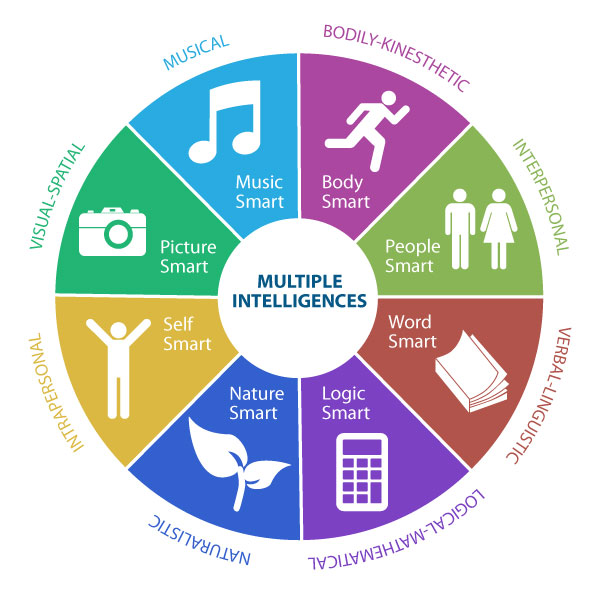Theory of Multiple Intelligences looks at the full range of abilities and talents that people possess. Howard Gardner theorised that people have many kinds of intelligence. Gardner, a psychologist and professor of neuroscience at Harvard, developed this theory in 1983 and he defines “intelligence” not as an IQ but, rather, as the skills that enable anyone to gain new knowledge and solve problems. However there is no one way that people learn, it can vary from subject to subject and over time.
Theory of Multiple Intelligences translates into learning styles and most people have a combination of different learning styles. All of these learning styles indicate different ways of interacting with the world. Each learning styles has its own strengths and weaknesses. Your students will have a preferred method of processing information and this varies from day to day.

Visual-Spatial (Picture Smart)
Visual or spatial learners are often referred to as a right-brained learner. They are typically good at deciphering visual data in the form of maps and graphs. They are imaginative, think outside of the box and quickly process what they see rather than what they hear.
Ways to Enhance Learning
- Use charts, graphs, maps, diagrams, time lines and infographics.
- Implement digital tools and technology to assist learning.
- Create outlines with different levels instead of blocks of text.
Verbal-Linguistic (Word Smart)
Verbal learners are adept at processing information through the use of language. They excel at reading, writing, listening and speaking. They have an excellent memory for things they have read and enjoy all types of word games, puns, rhymes and tongue twisters. Many of them also enjoy learning different languages. These learners particularly enjoy their writing, drama and speech classes.
Ways to Enhance Learning
- Take thorough notes
- Create lists; statistics and facts.
- Use mnemonic devices
Logical-Mathematical (Logic Smart)
Logical learners are skilled at mathematical and logical reasoning. They are able to solve problems involving numbers and can easily decipher abstract visual information. They are also adept at analysing cause and effect relationships and tend to think linearly. They like to classify and group information, as well as create ordered lists, agendas and itineraries.
Ways to Enhance Learning
- Understanding the key concepts
- Create lists; statistics and facts.
- Use role playing and games
- Track your progress and goals
Auditory-Musical (Music Smart)
Auditory (musical) learners thinks in sounds rather than images. They think chronologically and learn best through step-by-step methods. Unlike visual learners, they have an impeccable memory for conversations and enjoy debates and discussions. They have strong language skills and perform well on oral exams. As the name suggests, they also have musical talents and are able to discern individual notes, rhythms and tones.
Ways to Enhance Learning
- Participate in discussions and debates.
- Include audio in programming
- Listen to music
- Use mnemonic devices
Social-Interpersonal (People Smart)
Social (interpersonal) learners learn best through interactions with other people. They usually enjoy working in a group setting and bouncing ideas off of other people. Social learners are good at reading others’ emotions and facial expressions, as well as relationship dynamics.
Ways to Enhance Learning
- Create flexible learning spaces
- Use role playing and games
- Peer learning.
Intrapersonal (Self Smart)
Intrapersonal, or solitary, learner likes to use self-study and work alone. Usually, solitary learners are in tune with their feelings, who they are and what they are capable of doing. These types of learners are very independent, so they guide themselves on their journey to learning something new each day.
Ways to Enhance Learning
- Create flexible learning spaces
- Track your progress and goals
- Find connections
Bodily-Kinesthetic (Body Smart)
Physical (kinesthetic) learners are always moving and doing something with their hands. They learn best when their bodies are involved in the learning process. This can mean anything from creating artwork with their hands to being able to manipulate what is being learned. These types of learners benefit from larges spaces that enable them to draw and write. They can also find walking back and forth while reading conducive to their learning. It comes to no surprise that physical learners are many times athletically gifted and tend to live in the present moment rather than in the future or the past.
Ways to Enhance Learning
- Hands-on lessons
- Use role playing and games
- Peer learning
Naturalistic (Nature Smart)
Naturistic learners process information best when it is related to finding patterns in nature and applying scientific reasoning to the understanding of living creatures. These learners particularly enjoy being outdoors and connecting with Nature. They are often found observing and appreciating plants and animals in rural settings.
Ways to Enhance Learning
- Identify and classification
- Pick topics that are related to daily life
- Observe and record data.
Remember there is no one right way to learn.
Student’s “learning style” may not predict the way they prefer to be taught or the way they actually choose to study on their own (Newton & Salvi, 2020). Students’ learning preferences as identified via questionnaires do not predict the singular, best way to teach them. A single student may learn best with one approach in one subject and a different one in another. The best approach for them may even vary day-to-day. Most likely, students are best served when a variety of strategies are employed in a lesson. Read more of the ‘Different Learning Styles—What Teachers Need To Know’ article.

